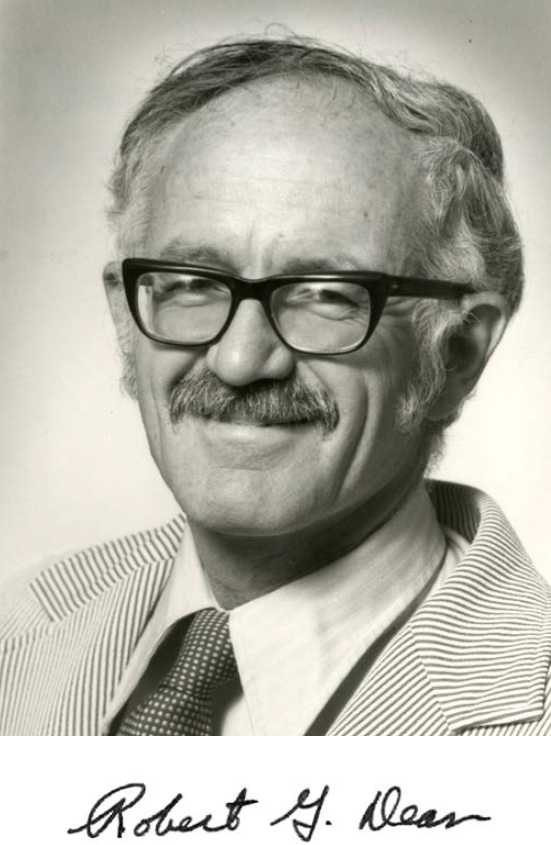ROBERT G. DEAN
1930–2015
Elected in 1980
“Contributions to field, laboratory, and analytical researches clarifying wave, erosion, and coastal processes developing relevant analytical procedures.”
BY ROBERT A. DALRYMPLE
ROBERT GEORGE DEAN, a world-renowned coastal engineering scientist and engineer, died at age 84 on February 28, 2015, in Gainesville, Florida. He was an emeritus graduate research professor at the University of Florida at the time, having spent 30 years of his career teaching coastal engineering there.
Bob was born November 1, 1930, to George Horton Dean and Harriet Blevins Dean in Laramie, Wyoming. He began college at Long Beach City College, intending to do refrigerator repair, but after receiving an associate of arts degree in 1952, he transferred to the University of California, Berkeley for his BS in civil engineering in 1954. In April that year he married Phyllis Thomas, beginning a 60-year-long partnership.
He then attended Texas A&M University for his master’s degree (1956) and the Massachusetts Institute of Technology for his DSc, which he received in 1959.
After a year at MIT as an assistant professor of civil engineering, he took a job with Chevron Research Corporation in La Habra, California, working on the design of offshore oil platforms. It was during this time that he developed the stream function wave theory, a computationally efficient numerical method to compute the properties of nonlinear water waves.
He worked in the oil industry for five years and then moved to the University of Washington for a year, until he was
offered the chairmanship of the Coastal and Oceanographical Engineering Department at the University of Florida, the first coastal engineering program in the country. With the exception of a seven-year hiatus at the University of Delaware as Unidel Professsor of Civil Engineering, he was a Gator.
One aspect that characterized Bob’s research career was his amazing ability to recognize the correct physics applicable to a problem, write down the appropriate equations, and then simplify the approach to make the solution look easy and intuitive, much as a gifted athlete makes a sport look easy.
Throughout his professional life, Bob was intrigued by coastal processes, such as tidal inlets, beach morphology, sand transport, and of course waves. Early in his career at the University of Florida, he invited Morrough P. O’Brien, former dean at UC Berkeley, to spend part of his retirement at the university, where they worked on the stability of tidal inlets. Bob provided the hydrodynamics needed to explain why inlets opened or closed during storms.
At Delaware (1975–1982), he provided a theoretical background to Bruun’s idea of an equilibrium profile—that is, that there is a concave upward shape to a beach and that it could be described by a simple algebraic formula, relating depth to distance offshore. Using this equilibrium profile, he tackled a number of vexing problems, such as providing a comprehensive approach to the design of beach nourishment. Also during this time, he and I wrote the textbook Water Wave Mechanics for Engineers and Scientists (Prentice-Hall, 1984), which has been in print for 30-plus years as an introductory text for coastal engineering.
Recruited back to the University of Florida as a graduate research professor, he continued working on the technology of beach fills, leading to Beach Nourishment: Theory and Practice (World Scientific Publishing Company, 2003), followed shortly by the textbook Coastal Processes with Engineering Implications (Cambridge University Press, 2004).
Bob’s immense contributions to the fundamentals of coastal engineering in so many areas were recognized by the American Society of Civil Engineers, which awarded him the International
Coastal Engineer Award in 1983 and the John G. Moffatt–Frank E. Nichol Harbor and Coastal Engineering Award in 1987. He was made a distinguished member of ASCE in 2010.
Bob also provided considerable service to the US Army Corps of Engineers, serving for 17 years as a member of the Coastal Engineering Research Board, which provides coastal engineering research advice to the chief of engineers and the Coastal and Hydraulics Laboratory (formerly the Coastal Engineering Research Center) in Vicksburg, Mississippi (1968–1980; 1993–1998). He also participated, postretirement, in a forensic study of the flooding of New Orleans (Interagency Performance Evaluation Task Force), for which he received his second Outstanding Civilian Service Award from the Army in 2008.
Bob was active in the work of the National Research Council, serving on six committees and chairing two very influential ones that produced the reports Responding to Changes in Sea Level: Engineering Implications (1984–1986) and Drawing Louisiana’s New Map: Addressing Land Loss in Coastal Louisiana (2002–2006). He also served on the Committee on Natural Disasters (1982–1986), which provided FEMA with guidance for wave and surge calculations during hurricanes, and the Marine Board (1981–1986).
The ASCE Coastal Engineering Research Council is the custodian of the most important international conference on coastal engineering. As chair for 12 years (1992–2004) Bob kept it focused on serving the profession by saying “We do one thing and we do it well.”
His contributions to the profession and to the state of Florida (as a professor and as director of the Division of Beaches and Shores in the Department of Natural Resources, 1985–1987) were recognized by several awards from the Florida Shore and Beach Preservation Association: the Jim Purpura Award (1979), the Gold Medal (1987), and the Bill Carlton Award (1996). The national American Shore and Beach Preservation Association awarded him the Morrough P. O’Brien Award in 2001.
After he retired in 2003, Bob said to me, “You know, coastal engineering is also my hobby.” And with that, he went right
on working on coastal engineering problems, consulting on Hurricane Katrina and advising students, even going into the office regularly.
Bob is survived by Phyllis, daughter Julie Dean Rosati (a coastal engineer with the US Army Corps of Engineers), son Tim, and five grandchildren.







